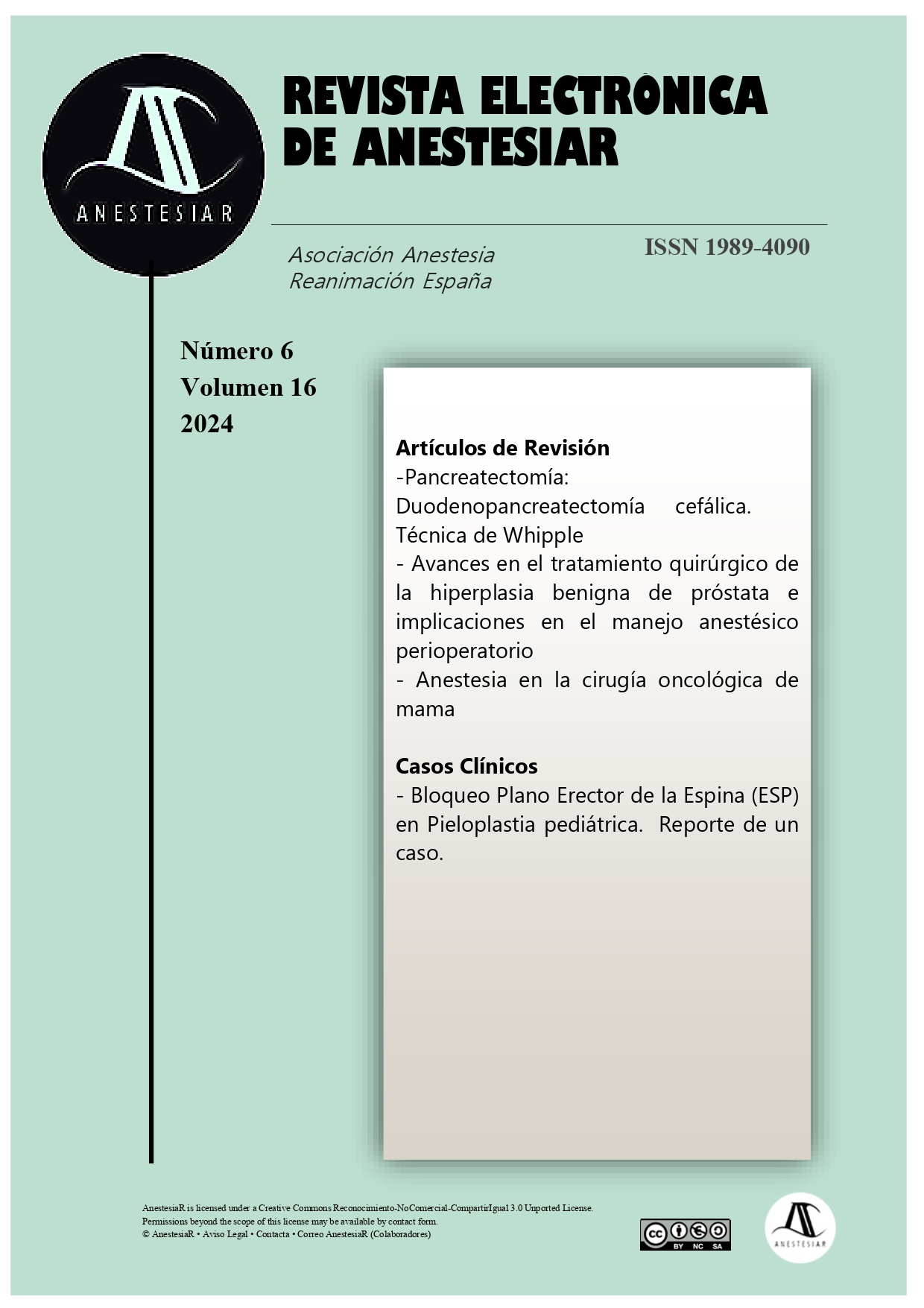Advances in the surgical treatment of benign prostatic hyperplasia and implications for perioperative anesthetic management
DOI:
https://doi.org/10.30445/rear.v16i6.1188Keywords:
Benign prostatic hyperplasia, Post-TUR syndrome, irrigation fluid, laserAbstract
Benign prostatic hyperplasia (BPH) is a highly prevalent disease in men worldwide. Lifestyle changes and medication are the first two steps in treating this condition, with surgery reserved for cases of treatment failure or the appearance of complications such as hematuria, bladder stones, recurrent urinary tract infections, or urinary retention.
Before the introduction of transurethral resection of the prostate (TURP), patients with BPH underwent open surgical procedures. TURP was an innovation that demonstrated that prostatic tissue could be resected through a cystoscope, making it possible to safely remove most of the adenoma near the prostatic capsule. In the last 15 years, further advances have been made, demonstrating that endoscopic enucleation of the prostatic adenoma with laser can be performed, similar to open surgery.
Irrigation fluid absorption is multifactorial and leads to cardiovascular, central nervous system, and metabolic disturbances, resulting in the well-known post-TURP syndrome. The clinical presentation of this syndrome varies depending on the characteristics of the irrigation fluid.
With the evolution of TURP toward bipolar technique and the introduction of new laser techniques, physiological saline (0.9% NaCl) is now used as the irrigation fluid, which leads to a new post-TURP syndrome with a different clinical presentation and treatment compared to the previous one.
References
- VUICHOUD C, LOUGHLIN KR. Benign prostatic hiperplasia: epidemiology, economics and evaluation. Can J Urol 2015;22(Suppl 1):1-6.
- Medical treatment of benign prostatic hyperplasia - UpToDate sep 2021.
- Dombier R, Pahouja G, Branch J, McVary KT. The New American Urological Association Benign Prostatic Hyperplasia Clinical Guidelines: 2019 Update. Current Urology Reports (2020) 21:32.
- Ho HSS, Cheng CWS. Bipolar transurethral resection of prostate: a new reference standard? Current Opinion in Urology 2008, 18:50-55.
- Mamoulakis C, de la Rosette J. Bipolar Transurethral Resection of the Prostate: Darwinian Evolution of an Instrumental Technique. Urology 85:1143-1150, 2015.
- Tang Y, Li J, Pu C, Bai Y, Yuan H, Wei Q, Han P. Bipolar transurethral resection versus monopolar transurethral resection for benign prostatic hypertrophy: a systematic review and meta-analysis. Journal of endourology. Volumen 28, Number 9, September 2014. Pp. 1107-1114.
- Guidelines on Lasers and Technologies. European Association of Urology 2014.
- Das AK, Teplitsky S, Humphreys MR. Holmium laser enucleation of the prostate (HoLEP): a review and update. Can J Urol 2019;26(Suppl 1):13-19.
- Kabalin JN, Gilling PJ, Fraundorfer MR. Holmium:Yttrium-Aluminium-Garnet Laser Prostatectomy. Mayo Clin Proc 1998K;73:792-797.
- Hyponatremia following transurethral resection, hysteroscopy, or other procedures involving electrolyte-free irrigation - UpToDate sep 2021.
- Ortner G, Nagele U, Herrmann TRW, Tokas T. Irrigation fluid absorption during transurethral bipolar and laser prostate surgery: a systematic review. World Journal of Urology. Published online: 30 June 2021.
- Park HP. Irrigation fluids used for transurethral resection of the prostate: a double-edged sword. Korean J Anesthesiol 2019 April 72(2): 87-88.
- Lerner LB, Rajender A. Laser prostate enucleation techniques. Can J Urol 2015;22(Suppl 1): 53-59.
- Hanson RA, Zornow MH, Conlin MJ, Brambrink AM. Laser Resection of the Prostate: Implications for Anesthesia. Anesth Analg 2007;105:475-9.
- Postoperative visual loss after anesthesia for nonocular surgery - UpToDate jun 2021.
- Clemente LM, Ramasco F, Platas A, Archilla J, Romero I, Corbacho C, Allona A. Sindrome de reabsorción post-resección transuretral (RTU) de próstata: revisión de aspectos fisiopatológicos, diagnósticos y terapéuticos. Actas Urol Esp. 25 (1): 14-31, 2001.
- Surgical treatment of benign prostatic hyperplasia (BPH) - UpToDate Sep 2021.
- Balzarro M, Ficarra V, Bartolini A, Tallarigo C, Malossini G. The Pathophysiology, Diagnosis and Therapy of the Transurethral Resection of the Prostate Syndrome. Urol Int 2001;66:121-126.
- Cleves A, Dimmock P, Hewitt N, Carolan-Rees G. The TURis System for Transurethral Resection of the Prostate: A NICE Medical Technology Guidance. Appl Health Econ Health Policy (2016) 14:267-279.
- Hahn RG. The Use of Ethanol to Monitor Fluid Absorption during Transurethral Resection of the Prostate. Scand J Urol Nephrol 33: 277-283, 1999.
Downloads
Published
How to Cite
Issue
Section
License
Copyright (c) 2024 Revista Electrónica AnestesiaR

This work is licensed under a Creative Commons Attribution-ShareAlike 4.0 International License.
 Envío y derechos de autor
Envío y derechos de autor


 Revista Electrónica AnestesiaR by
Revista Electrónica AnestesiaR by 